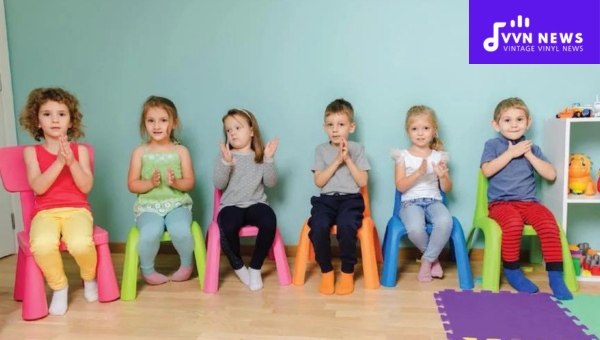Learning music can be both fun and educational for students, especially when it involves interactive games. Finding the best resource that successfully merges learning with enjoyment could feel a little overwhelming.
If you’ve been scratching your head over this, worry no more! In this blog post, we take a look at the top music theory games for the classroom that can help students gain valuable knowledge while keeping them engaged and entertained.
Games geared towards learning music theory are powerful educational tools that not only enhance the student’s theoretical understanding but also improve their musical skills.
These games introduce an element of fun into the classroom setting. Improved memory retention, better focus, and heightened engagement from your students – everything a classroom needs for effective learning!
Top Music Theory Games For The Classroom
Interactive learning methods facilitate a fun-filled experience for students and music theory games serve this purpose brilliantly!

These games go the extra mile to instill theoretical understanding, enhance musical skills, and transform learning into an exciting event.
Let’s check out these engaging games that effectively tick all those checkboxes:
Master the Stave
The Master the Stave game is an exceptional way to introduce students to reading musical notation.
Imagine transforming the typical stave into an interactive classroom adventure.
In this game, each line or space on the stave represents a different level or challenge that students must conquer by correctly identifying notes.
What makes it so captivating is that you can tailor it to different difficulty levels depending on your class’s proficiency.
For starters, you might use simple one-line melodies, gradually increasing complexity with ledger lines and accidentals as you progress.
This interactive gameplay allows students to visually and aurally connect with each note, reinforcing note recognition in a hands-on manner.
Also Read: How To Transpose Music? [Simplifying Key Changes In Songs]
Master Your Rhythm
Master Your Rhythm sharpens rhythmic accuracy in an incredibly engaging way.
Here, rhythm patterns become puzzles that students must solve either individually or as teams.
Students may clap, tap, or use classroom instruments to replicate given rhythms.
You can elevate the experience by using technology. There are online rhythm trainers that offer real-time feedback, showing your class immediate performance results.
instant grading system makes it thrilling for students as they strive to beat their last score or challenge their classmates in rhythm duels.
Hot Potato
Nothing combines anticipation and music knowledge like Hot Potato, where passing around an object mimics the ticking of a musical timer.
You can modify this classic game by playing music and instructing your class to pass around a bean bag (the ‘potato’) until the music stops—whichever student ends up holding the ‘potato’ when silence falls must answer a question related to music theory.
This could range from identifying chord structures to explaining scales.
The unpredictability of when the music will pause adds excitement and keeps everyone on their toes—quite literally! Integrating fun rewards for correct answers can also enhance student motivation.
Musical Stepping Stones
Embarking on a journey across Musical Stepping Stones is one of those activities where physical movement supports learning concepts—imagine hopscotch but with musical intervals or symbols instead of numbers.
Create stepping stones out of paper or fabric cutouts each labeled with various music theory elements such as notes, dynamics, rests, etc., and spread them out across your classroom floor.
To advance from stone to stone, a student must answer something about what’s written on their current spot—a question about what’s adjacent might lead to some exciting leaps across the room!
Because students are moving and thinking simultaneously in this activity, it promotes kinetic learning which has been shown to boost memory retention significantly.
Tempo Challenger
In the classroom, Tempo Challenger is a dynamic game that excites students about different musical tempos.
The concept is straightforward yet effective: pupils must identify or match compositions to their respective tempos.
Moderato, Allegro, and Presto are no longer just abstract terms; they become tangible tools for a student’s musical growth through hands-on experience.
The game typically starts with students listening to various pieces played at different speeds.
Then, they classify them according to tempo markings, developing their listening skills and internal metronome.
By challenging one another – or even the entire class – to recognize tempi with greater accuracy, learners reinforce their newfound knowledge in an interactive environment.
Also Read: How To Transpose Bass Clef To Treble Clef [A How-To Guide]
Playing Fraction Pies by David Tulga
With Playing Fraction Pies, innovative software developer David Tulga offers a resource that blends music theory with mathematical principles.
Using fractions to represent musical note values, the game familiarizes students with note durations in a visual and hands-on manner.
Here’s how it works: Players assemble “fraction pies” that equate to a full musical measure.
example, half-notes are represented as 1/2 pies, while quarter-notes are shown as 1/4 pies.
This exercise educates students on how different notes fit within measures, teaching rhythm and beat division while seamlessly integrating cross-curriculum learning.
Connect Four Composition
Connect Four Composition takes the familiar framework of Connect Four and repurposes it for music theory education.
Students use colored chips that correspond to specific pitches or rhythms. When lined up horizontally or vertically, these chips form a melody or rhythmic pattern.
The teacher sets rules regarding which chips translate into particular musical elements — C might be red, D may be blue — establishing a code that students follow during gameplay.
As they strategize over chip placement for gameplay advantage, they’re also crafting compositions intuitively.
Musical Notes/Terms Egg Matching Game
For a thrilling Easter-themed twist on classroom learning, the Musical Notes/Terms Egg Matching Game perfectly fits the bill.
It’s as simple as filling plastic eggs with pairs of music notes or terminology on small slips of paper – one term per egg half so that when paired correctly, it forms an egg again.
This engaging activity not only reviews music theory concepts but also enhances kinesthetic learning through tactile manipulation of notes and terms like forte, crescendo, or half-note.
As students dash around trying to find matching halves during spirited rounds of competitive play and discovery, active recall comes into play — driving home lessons most delightfully.
Canon
Discussing canons becomes more than analyzing patterns; quick recognition of sequences takes center stage when playing the Canon game in class.
Leap beyond mere auditory exercises — students become performers who must create canons themselves using instruments or their voices from given starting phrases.
Allowing young musicians to create complex rounds (a la Pachelbel) challenges their compositional skills while fostering creativity within preset musical structures.
As each group presents its take on canon creation, peers learn by hearing countless variation possibilities stemming from single melodic lines.
Cosmic Whole Note
The Cosmic Whole Note game is an extraordinary experience that sends students on an interstellar journey through the foundations of note durations.
Picture your classroom transforming into a whimsical universe where each student pilots their spacecraft, powered by their knowledge of whole notes, half notes, and quarter notes.
In gameplay, you will project images of various notes onto the classroom screen while students, with their “spaceships” (which could be anything from paper cutouts to digital avatars), navigate through the cosmic terrain by identifying note values correctly.
Each correct identification allows them to continue cruising through the galaxy; a wrong answer might send them briefly off-course and offer an immediate opportunity for learning and correction.
Also Read: F Sharp Minor Pentatonic Scale [How To Use In Your Compositions]
Mission Transposition
Engage students with Mission Transposition, a covert operation that challenges them to shift musical notes up or down in pitch according to a given interval. This task keenly reinforces key signatures and scales.
You might present a simple melody and assign each student or team a new key signature mission: transpose the melody correctly into the new key signature.
Incorporate dynamics of cooperative learning—once a student completes their mission, they can become “agents” providing hints or assistance to classmates still on the field.
Flash Cards Class Game
Integrating flash cards into music education has proven effective time and again but turn this study staple into a vibrant Flash Cards Class Game by introducing competition and collaboration.
Create flashcards with different music theory concepts—note names, scales, key signatures—and challenge individuals or groups to answer as many as they can within a specified time.
For extra excitement, use online tools like Quizlet or create your database of digital cards for interactive whiteboard use.
Interval Train
Hop aboard the Interval Train game – it’s designed to drill intervals but in a way, that’s much more enthralling than simple repetition.
In this game, each interval is denoted as a train car coupling together harmonic or melodic combinations along tracks drawn across your whiteboard or displayed via an interactive screen.
Begin by laying out trains that consist of various intervals—that might be seconds apart all up to octaves.
As students call out or play intervals on their instruments correctly, they effectively link cars to form complete trains – reinforcing both interval recognition and ear training simultaneously.
Play That Note
In Play That Note, students get hands-on instrument experience while underpinning their notation reading abilities.
This real-time exercise pairs well with any classroom setup inclusive of instruments such as pianos, xylophones, recorders—you name it!
Here’s how it works: flash a note on the screen or name it out loud; students race to find and play the matching pitch on their instrument.
Implement varying levels ranging from simplistic single-note strikes for novices ascending to intricate chord structures for advanced maestros-in-training.
Through clever shaping such as these games encapsulated above—with an emphasis on interaction—music theory becomes not just another school subject but rather an invitation into an engaging world where learning feels like playtime enriched with purposeful education.
Also Read: D Minor Triad [A Crucial Element In Music Composition]
FAQs
How do music theory games benefit classroom learning?
Music theory games enhance engagement and retention by turning abstract concepts into interactive challenges that can cement knowledge through play.
Can these games be used for all age groups?
Yes, many music theory games are adaptable to suit different skill levels, making them perfect for a variety of age groups and experience levels.
Do I need special equipment to use these games in my classroom?
Most music theory games do not require special equipment and can be played with common classroom materials or accessed online.
How much time should I allocate to playing music theory games in class?
Brief sessions of 15-30 minutes can suffice, ideally as warm-up activities or toward the end of class to reinforce the day’s lessons.
Are there any online resources for music theory games?
Certainly! Websites like musictheory.net and classicsforkids.com offer a range of interactive games that are perfect for the classroom setting.
Also Read: A Minor Scale [Unlock The Mysteries Of Musical Composition]
Conclusion
Integrating music theory games into your classroom can greatly enrich your students’ learning experience. By adopting these interactive and enjoyable methods, you’re setting the stage for deeper understanding and long-term retention of musical concepts.
it’s mastering rhythms with ‘Hot Potato’ or constructing compositions with ‘Connect Four Composition,’ these games cater to various learning styles and preferences.
Don’t hesitate to explore these resources further by visiting relevant music education websites for additional details and game variations. Give your students the gift of music education that resonates beyond the classroom walls!








